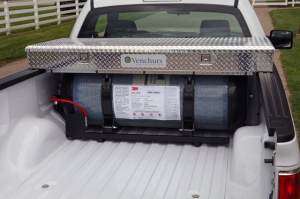Are Bi-fuel Gaseous Trucks Sustainable?

- Robert Menard
Certified Purchasing Professional,
Certified Professional Purchasing Consultant, Certified Green Purchasing Professional, Certified Professional Purchasing Manager
In August 2012, I blogged about Chrysler’s new Compressed Natural Gas (CNG) pick up trucks to compete with Chevy and GMC vehicles. This 2014 model year, Ford jumps into the fray for half-ton pickups.
As with all matters of sustainability, nothing is clear or obvious. The vehicles can achieve up to 750 miles on a single fill up, about double that of a traditional gasoline or diesel powered truck but the size of CNG and Liquefied Petroleum Gas (LPG) , primarily a mixture of propane and butane. There are substantial detrimental factors that impact sustainability of these pickups. These include upfront costs which must be paid back, lack of refilling stations, and reduced cargo space.
According to ENR’s August 12, 2013 edition, the cost of a gaseous bi-fuel equipped half ton truck runs between $7,500 and $9,500 more than comparable gasoline equipped models. Inexplicably, “Ford covers the gaseous-ready engine components only under its standard five-year, 60,000 power-train warranty.”
A CNG industry advocate website notes that CNG prices in June 2013 ran about $2.06 per gasoline-gallon equivalent or $1.61 per gallon less. This sounds good but I can find no accounting of Btu/$, the acid test for equating alternative forms of energy. Research for my book, Green Purchasing and Sustainability, proved that gasoline is intrinsically 25% more energy dense, in terms of equivalent units of fuel. This inherent difference would alter the website’s calculus. Assuming no change in CNG or gasoline prices over the payback period, the 25% per gallon advantage of gasoline reduces the CNG price per gallon to $1.20
A Ford spokesperson is quoted in a statement, “With the money saved using CNG, customers could start to see payback…in as little as 24 to 36 months. No substantiating calculation was offered in the brief ENR story so let’s do our own. Using $8,500 as the up-fit charge for the bi-fueled engine, $8,500/($1.20/galloon)= 7,083 gallons. No mileage is specified in the ENR story, and resort to Ford’s website showed no mileage figure either. This payback calculation is unjustified by any means.
The lack of refilling stations is a substantial impediment. Have you ever seen one? My radar is set high for these events and although I travel the country fairly regularly, I have only seen a few, mostly in the usual suspect locales like Washington, DC, San Francisco, and similar venues. In Texas where I live, which has more pickup trucks than any state, I have never seen one!
 As to reduced cargo space, here is a photo of the pickup truck’s bed. Note that what otherwise would be seen as a tool box is actually a gaseous fuel tank. It extends from the rear of the cab to the wheel wells, severely reducing the payload capacity in terms length, volume, and weight.
As to reduced cargo space, here is a photo of the pickup truck’s bed. Note that what otherwise would be seen as a tool box is actually a gaseous fuel tank. It extends from the rear of the cab to the wheel wells, severely reducing the payload capacity in terms length, volume, and weight.
So, where are we? First, Ford deserves recognition for its efforts to improve sustainability. It is also trying to respond to customer demand and appeal to those in its sales programs who favor sustainability, but do not fully understand how to achieve it.
The individual and corporate buyers must take all factors into account and decide which fuel alternative is more sustainable when buying half ton pickups.
Tell me your opinion.